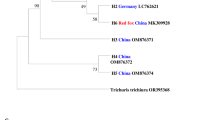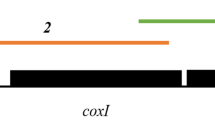Abstract
This is the first report of cryptosporidiosis in a bactrian camel (Camelus bactrianus) in China. Two Cryptosporidium isolates derived from the same bactrian camel (3-year-old) in November 2005 and April 2006 were characterized using sequence and phylogenetic analysis of the small-subunit rRNA (18S rRNA), 70-kDa heat shock protein (HSP70), actin and Cryptosporidium oocyst wall protein (COWP) genes. The sequences of the 18S rRNA and COWP were identical to all other Cryptosporidium andersoni isolates although minor differences were noticed between the isolates and the USA isolate at the actin locus (99.2% of similarity). The sequence of the HSP70 was identical to the Japanese C. andersoni isolate, with a minor difference from the Australian C. andersoni isolate (99.7% of similarity). Cross-transmission studies demonstrated that the C. andersoni isolates did not infect immunosuppressed or immunocompetent Kun-ming mice, severe combined immunodeficiency mice, and immunosuppressed or immunocompetent calves. Among the C. andersoni isolates reported so far, only isolates from Japan could infect SCID mice. Thus, the C. andersoni isolates from the bactrian camel were biologically similar to most bovine C. andersoni isolates characterized so far, but are different from bovine isolates from Japan.


Similar content being viewed by others
References
Andersoni BC (1991) Prevalence of Cryptosporidium muris-like oocysts among cattle populations of the United States: preliminary report. J Protozool 38:14s–15s
Arrowood MJ, Sterling CR (1987) Isolation of Cryptosporidium oocysts and sporozoites using discontinuous sucrose and isopycnic percoll gradients. J Parasitol 73:314–319
Arrowood MJ, Donaldson K (1996) Improved purification methods for calf-derived Cryptosporidium parvum oocysts using discontinuous sucrose and cesium chloride gradients. J Eukaryot Microbiol 43:89
Efron B, Halloran E, Holmes S (1996) Bootstrap confidence levels for phylogenetic trees. Proc Natl Acad Sci USA 93:13429–13434
Enemark HL, Ahrens P, Lowery CJ, Thamsborg SM, Enemark JM, Bille-Hansen V, Lind P (2002) Cryptosporidium andersoni from a Danish cattle herd: identification and preliminary characterization. Vet Parasitol 107:37–49
Fayer R, Santin M, Trout JM, Greiner E (2006) Prevalence of species and genotypes of Cryptosporidium found in 1–2-year-old dairy cattle in the eastern United States. Vet Parasitol 135:105–112
Felsenstein J (1989) PHYLIP: Phylogeny Inference Package (Version 3.2). Cladistics 5:164–166
Koudela B, Modry D, Vitovec J (1998) Infectivity of cryptosporidium muris isolates from cattle. Vet Parasitol 76:181–188
Koyama Y, Satoh M, Maekawa K, Hikosaka K, Nakai Y (2005) Isolation of Cryptosporidium andersoni Kawatabi type in a slaughterhouse in the northern island of Japan. Vet Parasitol 130:323–326
Kvac M, Vitovec J (2003) Prevalence and pathogenicity of Cryptosporidium andersoni in one herd of beef cattle. J Vet Med B Infect Dis Vet Public Health 50:451–457
Kvac M, Ditrich O, Kouba M, Sak B, Vitovec J, Kvetonova D (2004) Failed attempt of Cryptosporidium andersoni infection in lambs. Folia Parasitol (Praha) 51:373–374
Kvac M, Kouba M, Vitovec J (2006) Age-related and housing-dependence of Cryptosporidium infection of calves from dairy and beef herds in South Bohemia, Czech Republic. Vet Parasitol 137:202–209
Kvac M, Ondrackova Z, Kvetonova D, Sak B, Vitovec J (2007) Infectivity and pathogenicity of Cryptosporidium andersoni to a novel host, southern multimammate mouse (Mastomys coucha). Vet Parasitol 143:229–233
Lindsay DS, Upton SJ, Owens DS, Morgan UM, Mead JR, Blagburn BL (2000) Cryptosporidium andersoni n. sp. (Apicomplexa: Cryptosporiidae) from cattle, Bos taurus. J Eukaryot Microbiol 47:91–95
Masuno K, Yanai T, Hirata A, Yonemaru K, Sakai H, Satoh M, Masegi T, Nakai Y (2006) Morphological and immunohistochemical features of Cryptosporidium andersoni in cattle. Vet Pathol 43:202–207
Matsubayashi M, Kimata I, Abe N, Tani H, Sasai K (2004) The detection of a novel type of Cryptosporidium andersoni oocyst in cattle in Japan. Parasitol Res 93:504–506
Matsubayashi M, Kimata I, Iseki M, Hajiri T, Tani H, Sasai K, Baba E (2005) Infectivity of a novel type of Cryptosporidium andersoni to laboratory mice. Vet Parasitol 129:165–168
Morgan UM, Xiao L, Monis P, Sulaiman I, Pavlasek I, Blagburn B, Olson M, Upton SJ, Khramtsov NV, Lal A, Elliot A, Thompson RC (2000) Molecular and phylogenetic analysis of Cryptosporidium muris from various hosts. Parasitol 120:457–464
Ng J, Pavlasek I, Ryan U (2006) Identification of novel Cryptosporidium genotypes from avian hosts. Appl Environ Microbiol 72:7548–7553
Page RDM (1996) TREWVIEW: An application to display phylogenetic trees on personal computers. Comput Appl Biosci 12:357–358
Robinson G, Thomas AL, Daniel RG, Hadfield SJ, Elwin K, Chalmers RM (2006) Sample prevalence and molecular characterisation of Cryptosporidium andersoni within a dairy herd in the United Kingdom. Vet Parasitol 142:163–167
Satoh M, Hikosaka K, Sasaki T, Suyama Y, Yanai T, Ohta M, Nakai Y (2003) Characteristics of a novel type of bovine Cryptosporidium andersoni. Appl Environ Microbiol 69:691–692
Sulaiman IM, Morgan UM, Thompson RC, Lal AA, Xiao L (2000) Phylogenetic relationships of Cryptosporidium parasites based on the 70-kilodalton heat shock protein (HSP70) gene. Appl Environ Microbiol 66:2385–2391
Sulaiman IM, Lal AA, Xiao L (2002) Molecular phylogeny and evolutionary relationships of Cryptosporidium parasites at the actin locus. J Parasitol 88:388–394
Thompson JD, Gibson TJ, Plewniak F, Jeanmougin F, Higgins DG (1997) The Clustal X windows interface: flexible strategies for multiple sequence alignment aided by quality analysis tools. Nucleic Acids Res 24:4876–4882
Xiao L, Escalante L, Yang C, Sulaiman I, Escalante AA, Montali RJ, Fayer R, Lal AA (1999a) Phylogenetic analysis of Cryptosporidium parasites based on the small-subunit rRNA gene locus. Appl Environ Microbiol 65:1578–1583
Xiao L, Morgan UM, Limor J, Escalante A, Arrowood M, Shulaw W, Thompson RC, Fayer R, Lal AA (1999b) Genetic diversity within Cryptosporidium parvum and related Cryptosporidium species. Appl Environ Microbiol 65:3386–3391
Xiao L, Limor J, Morgan UM, Sulaiman IM, Thompson RC, Lal AA (2000) Sequence differences in the diagnostic target region of the oocyst wall protein gene of Cryptosporidium parasites. Appl Environ Microbiol 66:5499–5502
Xiao LH, Fayer R, Ryan U, Upton SJ (2004) Cryptosporidium Taxonomy: recent advances and implications for public health. Clin Microbiol 17:72–97
Acknowledgements
This study was supported by the National Natural Science Foundation of China (number 30371079) and Henan Innovation Project for University Prominent Research Talents (number 2004KYCX002) and the Program for New Century Excellent Talents in University (number NCET-05-0382). We gratefully thank Professor R. B. Williams, the Coxitec Consulting, United Kingdom, for his critical reading of the manuscript.
Author information
Authors and Affiliations
Corresponding author
Rights and permissions
About this article
Cite this article
Wang, R., Zhang, L., Ning, C. et al. Multilocus phylogenetic analysis of Cryptosporidium andersoni (Apicomplexa) isolated from a bactrian camel (Camelus bactrianus) in China. Parasitol Res 102, 915–920 (2008). https://doi.org/10.1007/s00436-007-0851-x
Received:
Accepted:
Published:
Issue Date:
DOI: https://doi.org/10.1007/s00436-007-0851-x




